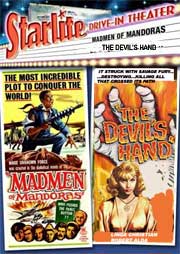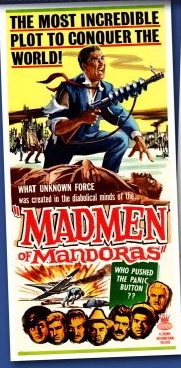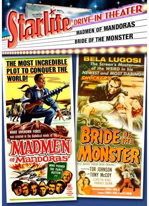| Release List | Reviews | Price Search | Shop | Newsletter | Forum | DVD Giveaways | Blu-Ray/ HD DVD | Advertise |
| Reviews & Columns |
|
Reviews DVD TV on DVD Blu-ray International DVDs Theatrical Reviews by Studio Video Games Features Collector Series DVDs Easter Egg Database Interviews DVD Talk TV DVD Talk Radio Feature Articles Columns Anime Talk DVD Savant HD Talk Horror DVDs Silent DVD
|
DVD Talk Forum |
|
|
| Resources |
|
DVD Price Search Customer Service #'s RCE Info Links |
|
Columns
|
 |
Madmen of Mandoras |

|
Madmen of Mandoras (+They Saved Hitler's Brain) & The Devil's Hand BCI Eclipse (Brentwood) B&W 1:37 flat full frame Street Date September 26 , 2006 12.98 Reviewed by Glenn Erickson |
The marginal distributor Crown International was a going concern in the 1960s; I remember seeing movies like Terrified and First Spaceship on Venus in movie houses packed with kids. This double bill of B&W thrillers is an object lesson in the pitfalls of low budget filmmaking. Madmen of Mandoras tried for far too much on a grade Z budget and earned a permanent place on 'all-time worst' film lists, while the unprepossessing The Devil's Hand gets decent marks as a modestly successful horror thriller. Both titles have floated around in bad prints and rip-off gray-market videos for decades, and this Starlite Drive-In Theater presentation gives us excellent transfers that finally allow a fair analysis. Madmen of Mandoras's alternate version They Saved Hitler's Brain is included, allowing a side-by-side comparison.

Madmen of Mandoras
1963 / 64, 74 min. / They Saved Hitler's Brain 92 min
Starring Walter Stocker, Audrey Caire, Carlos Rivas, John Holland, Dani Lynn, Nestor Paiva
Cinematography Stanley Cortez
Art Direction Frank Sylos
Film Editor Alan Marks
Written by Steve Bennett, Richard Miles
Produced by Steve Bennett, Carl Edwards, Anthony Sanucci
Directed by David Bradley
Madmen of Mandoras deserves most of the derision it receives, but there are plenty of explanations for its abject failure. Not excuses, mind you, explanations. Its maker is David Bradley, a minor notable among directors with an truly odd career. Bradley was a lecturer at UCLA, and an eccentric and unappreciated Hollywood personality.
Nefarious spies spirit away Professor John Coleman (John Holland), the only man who can synthesize an antidote for a deadly nerve gas. Coleman's daughter Kathy (Audrey Caire) and security agent son-in-law Phil Day (Walter Stocker) are approached by suspicious Latin Teo Padua (Carlos Rivas), who is soon murdered after giving them only one clue: Mandoras. Kathy and Phil go to Mandoras and discover from Teo's handsome brother Camino (Rivas again) that both her father and her sister Suzanne (Dani Lynn) have been taken there as part of a diabolical Nazi plan to conquer the world. Camino explains how Adolf Hitler's head was kept alive and brought to the island nation. Now the Americans must escape and save the world. Can they trust the shady Presidente (Pedro Regas) and his police chief Alaniz (Nestor Paiva)?
Madmen of Mandoras is clearly a case, pardon the metaphors, of crazy ambition going for broke, only to crash and burn. The 'auteur' in question is David Bradley, a Chicago-born filmmaker who broke into Hollywood in the late 1940s by the unlikely route of home-made experimental films (see Savant's Unseen Cinema review) and 16mm feature versions of Julius Caesar and Peer Gynt. Bradley's star in these films was the young Charlton Heston, who was soon picked up by Hal Wallis and given star billing in his first feature. By some chain of events -- it's not determined to what extent Bradley and Heston helped each other, or if they were even in contact -- Bradley got a directing job on a low budget MGM feature starring George Murphy and Nancy Davis, Talk About a Stranger. Relocated to Hollywood, Bradley's directing output fell off. Despite mingling with top artistic names like James Agee, his career dwindled to a couple of juvenile delinquent and Science Fiction pictures in the late 50s and early 60s.
At UCLA, we knew David Bradley as an Associate Professor who taught film appreciation classes and lectured in an exaggerated theatrical style. His phenomenal 16mm library that was said to number into the thousands of classic titles, many of them silent films including (it was said) treasures to be found nowhere else. UCLA students got the benefit of access to his collection.
Madmen of Mandoras was his last picture. Bradley would sometimes show both it and Twelve to the Moon in his classes and complain bitterly about his producers. Bradley was driven by an aesthetic calling that did him little good in exploitation filmmaking, where evoking the art of Clarence Brown doesn't get a person very far. Someone like Roger Corman might simply call Bradley unreasonable and unrealistic. Bradley worked with atrocious scripts, but staffed those last two films with classy cameramen (John Alton, Stanley Cortez) and other name talent, and sometimes cast his silent movie star friends.
1I say all of the above to illustrate that an elevated appreciation of movie history doesn't translate into good moviemaking. Talk About a Stranger is an intimate dramatic story with carefully thought-out visuals, much like some of Bradley's experimental work. Twelve to the Moon and Madmen of Mandoras simply aren't stories that can be adequately filmed on a shoestring. Worse, they have terrible scripts that no directing genius could save. Both pictures are devoid of excitement. It's obvious that the budget for Madmen of Mandoras was expended on the interior dramatic scenes, which are competently filmed and lighted by Stanley Cortez with a look similar to his Night of the Hunter. But the dramatics and the logistics of the complicated plot are far too much for Bradley to handle. Corman would look at the project and say, too many characters, too many locations, too much bad writing. Bradley obviously went nuts trying to do the impossible.
About 50% of the show is lame footage of arrivals and departures at unconvincing locations. Nondescript buildings are meant to be government offices; Los Angeles neighborhoods and hilltop roads fool nobody. Griffith Park doesn't look like a Caribbean island and a President's palace shouldn't be just another house in a swanky Los Feliz neighborhood. Cars drive in broad daylight but when we cut inside (to that soundstage work) it's pitch dark. The Mandoras airport is obviously the space between some studio soundstages, with a travel poster and a potted palm tree wheeled in. The underground Nazi bunkers look suspiciously like concrete film vaults in Hollywood. We don't believe that scientists are scientists or that the secret agent hero is even a policeman; he doesn't behave in any way like an intelligence agent. Even when the acting is reasonable, the atrocious script (and Bradley's bad blocking) undermines every scene. It's not like we're even seeing a movie.
Critics always bring up the scene where Carlos Rivas is killed car-to-car at an intersection, because after the loud gunshot noise, Audrey Caire and Walter Stocker are surprised that Rivas is injured and then 'discover' that he's been shot. This is because Crown International dubbed in a loud gun sound effect, when Bradley intended the killers to use a silencer. The scene is yet another imitation of Fritz Lang's classic assassination from The Testament of Dr. Mabuse, repeated in his own The 1,000 Eyes of Dr. Mabuse and the Harry Palmer spy film The Ipcress File.
And that's the key: Bradley thought he was making a Mabuse-like sophisticated spy thriller. Probably filmed prior to the big success of Dr. No, Mandoras definitely has some 007 aspects, but Bradley's film might as well be called Plan Nine from Mandoras. The overall bankruptcy of the project makes fairly competent setups look idiotic: Taken by itself, name designer Paul Sylos' bunker operating room in the flashbacks is rather well done.
Madmen of Mandoras sputters to a feeble conclusion. Some sets are just pitifully poor and the depiction of Latin Americans is demeaning. The ending action (filmed in Bronson Caverns!) is simply awful, and the dumb conclusion ('wild' sister Suzanne marries Camino Padua, son of El Presidente) painfully lame. The fadeout ignores the fact that the lab security office back home is still rife with double agents.
Which of course brings us to the Hitler-head footage, which is bad-movie gold. Back in Germany, Hitler (Bill Freed) raves in 'geshputtle' nonsense Deutsch, and for no good reason ends up as a disembodied head in a bell jar tote-pak, like Luce Potter in Invaders from Mars. The persnickety paperhanger stays in the dome and grimaces, snarls and smiles nefariously, even when being driven around Mandoras in a black sedan!
Madmen of Mandoras reportedly received a brief theatrical run (a kind phrase) before showing up in the customary 2 a.m. TV slot for movies of the damned. Then at some point it was replaced by a variant version with a more direct schlock title, They Saved Hitler's Brain. That version is on this disc as well.
Judging by the look of things, to make They Saved Hitler's Brain almost two reels of brain-deadening extra content were slapped on to the front of Mandoras sometime in the early 70s. The main titles show some credit alterations but retain the old 1963 copyright date card. In the terrible new footage a pair of dull secret agents -- who look more like employees in a credit union -- drive around the streets of Van Nuys (Wayne Schmidt can pinpoint the houses!), playing car-tag with Evil Mandoras agents driving a beat-up Lincoln Continental to match the one in Bradley's footage. They're investigating the death of another scientist in eighteen additional minutes of pointless, incompetent padding clearly intended to bring the film up to length to fill a two-hour TV slot. Two violent stock shots are cribbed from Robert Mitchum's 1958 Thunder Road. The Madmen of Mandoras part of the show then plays out with minor changes, such as the shortening of the gory melting of Hitler's wax head. The new and old footage stand apart like night and day.
Madmen of Mandoras and They Saved Hitler's Brain teach important lessons in low-budget filmmaking: Don't make an epic on a dime store budget, and don't think that an elevated cinematic taste will prevent you from making one of the worst films of all time!

The Devil's Hand
1962 / 71 min. / The Naked Goddess, Lie to Love
Starring Linda Christian, Robert Alda, Neil Hamilton, Bruno ve Sota, Jeannie Carmen
Cinematography Meredith Nicholson
Art Direction Sherm Loudermilk, Herbert Smith
Film Editor Howard Epstein
Original Music Allyn Ferguson, Baker Knight, Michael Terr
Written by Jo Heims
Produced by Alvin K. Bubis, Jack Miles
Directed by William J. Hole Jr.
The Devil's Hand could be called a textbook example of good low-budget filmmaking in the early 1960s. Its modest aims are served well by a good script and professional acting. A more marketable name actor or two and a slight upgrade in sets could easily have turned this into a mainstream release ... but the studios might have balked at the story's suggestions of sensual, diabolical sex. The film's only other drawback is its lame, generic title.
Restrained and tasteful, The Devil's Hand could have qualified as a Television show, if the networks allowed programs about devil worship and sexual slavery. Although nothing censorable is shown, in the world of 1962 the overall idea that the hero is being seduced into abandoning his old girlfriend to a lingering death is definite exploitation material.
The film starts with the unpleasant Robert Alda falling under the spell of a witchy seducer who visits his dreams nightly. Never very likeable and not particularly attractive, Alda is the film's weak link, and we keep waiting for his character Rick to receive a demonic come-uppance for double-crossing his fiancée Donna in so heinous a manner. That Rick tries to rescue Donna doesn't get him off the hook in our estimation, as he happily enjoys Bianca's favors and knowingly joins a group of satanic Gamba worshippers. Rick the Rat acts out of selfish personal interests and of his own free will.
Like most films of this kind, the story shifts as much blame as possible onto the females. Donna (played with almost no accent by Mexican Ariadna Welter of Brainiac) puts pressure on Rick to marry and keep a job. Bianca is essentially a lamia who has sold her soul to the devil in the cult's pyramid scheme: Every member is responsible for the absolute loyalty of his or her recruits. This distinguishes her from Damn Yankees' Lola, who serves as a seductress reporting directly to Satan incarnate. Bianca is different in that she honestly wants Rick as her diabolical sex partner and soul (-less) mate. Her sponsor Frank (Neil Hamilton, Commissioner Gordon on TV's Batman) refers to the high death rate of Bianca's previous consorts, but we can tell she wants to keep Rick. Therefore, her jealousy for him is no different than that of any similarly conniving mortal female.
Linda Christian makes the picture work by suggesting all manner of erotic promise with just a smile and a few chaste nightgowns. Her acting is excellent and compensates for Alda's uninspired presence.
The cult's evil work seems limited to using magic to get rich, and the problem is to find the right hell-mate to share it with. Other members are single guys and serious couples, including a black couple. The meetings involve a black bongo player and sometimes a pair of black dancers (uncomfortably linking Evil with the black race) and what magic we see is of the general voodoo variety. Members are tested on an altar with a circular rig of swords suspended over their head, an idea swiped for 1995's Lord of Illusions. As the Doll master Frank, Neil Hamilton's fussy, clipped line delivery makes him an interesting menace, shoving a pin through the heart of a doll in Donna's likeness. How exactly Bianca wins bets on horse races isn't explained.
A few wrinkles are thrown in when we find out that cult spies are monitoring Rick's loyalty. When a journalist with a hidden camera is uncovered, it's bad news for his fearful sponsor, played by genre favorite Bruno ve Sota. Jeannie (Jeanne) Carmen (The Monster of Piedras Blancas) is another vixen dispatched to see if Rick can be tripped up. Short and sweet, the film ends in a conventional conflagration. William J. Hole Jr.'s direction, while not very stylish, is good with the dramatic aspects of the film.
The Devil's Hand is an interesting bridge between the urban covens of The Seventh Victim and Rosemary's Baby. The three films are different in content but take place in naturalistic city environments. Because we see the old Picfair movie theater in the background, we know that the accursed Doll Shop in The Devil's Hand is located on Pico Blvd, just West of La Cienega Boulevard. That's as mundane a Los Angeles location as one can ask for!
BCI Eclipse (or Brentwood)'s two-disc Starlite Drive-In Theater presentation of Madmen of Mandoras and The Devil's Hand feature excellent non-enhanced B&W transfers with perfect sound.
 The quality is sharp enough to properly crop both features to 1:78 on a widescreen TV, which approximates the correct theatrical compositions.
The quality is sharp enough to properly crop both features to 1:78 on a widescreen TV, which approximates the correct theatrical compositions.
The Drive-In feature allows one to watch the show with a selection of Crown International trailers, concession filler and even a blurry Woody Woodpecker cartoon. The Madmen of Mandoras disc is a flipper with They Saved Hitler's Brain on the opposite side; its quality is far inferior, and viewers will want to scan through only to see how the versions differ.
The packaging is attractive, if a little busy. The Devil's Hand was a last-minute substitute for Ed Wood's Bride of the Monster. On Amazon that cancelled double bill is still up (as of this date), with this new pairing not yet offered. Note the selling price -- The disc set is a bargain.
On a scale of Excellent, Good, Fair, and Poor,
Madmen of Mandoras rates:
Movie: Poor but fascinating in its badness
Video: Very Good
Sound: Very Good
Supplements: The alternate TV version They Saved Hitler's Brain.
The Devil's Hand rates:
Movie: Very Good
Video: Very Good
Sound: Very Good
Supplements:
Packaging: 2 discs in normal Keep case
Reviewed: September 30, 2006
Footnotes:
1. I was invited to one of Bradley's New Year's parties around 1976, just about the only Hollywood Hills event I ever attended. His guests were Karl Struss, Miliza Korjus, Forrest Ackerman and Ray Harryhausen -- sort of a combination waxworks and fan club. His house was decorated with an original metal submarine miniature from the 1929 Mysterious Island!
I also met the charming Carlos Rivas (The King and I, The Black Scorpion) on a commercial shoot circa 1986 or so. He was excited to find someone who knew about his old movies, but became suddenly absent-minded when I asked about Mandoras ... and then claimed he'd never gotten the chance to see it. Good answer.
Return
Review Staff | About DVD Talk | Newsletter Subscribe | Join DVD Talk Forum
Copyright © DVDTalk.com All rights reserved | Privacy Policy | Terms of Use
|
| Release List | Reviews | Price Search | Shop | SUBSCRIBE | Forum | DVD Giveaways | Blu-Ray/ HD DVD | Advertise |





